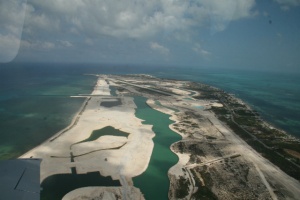Lubert-Adler and Dean Adler among Defendants in New Ginn Sur Mer Lawsuit
Attorney Dana Ballinger’s latest lawsuit against various Ginn entities rips Bobby Ginn’s video explaining the Ginn sur Mer/Credit Suisse loan default.
Palm Coast, FL – March 7, 2011 – Dana Ballinger rivals Bankruptcy Trustee Drew Dillworth’s tenacity in her ongoing quest to seek justice for alleged wrongs committed by several Bobby Ginn entities. Dillworth is trying to collect millions from Ginn and his financial partner Lubert-Adler; funds tied to the bankruptcy of two of Ginn’s developments, Tesoro and Quail West, following a Credit Suisse loan default. Ballinger seeks compensation for alleged fraud related, in part, to the same Credit Suisse credit facility. Her latest lawsuit, Taliaferro v. ERG Enterprises, lists several new plaintiffs and adds Lubert-Adler and Dean Adler to the list of defendants. ERG is Edward Robert (Bobby) Ginn. The lawsuit was filed March 3rd and is assigned to
Judge Timothy Corrigan.
 Dana Ballinger bought a lot in Ginn sur Mer, Ginn’s $4.9 Billion mega yacht, golf, and casino project at West End, Grand Bahama. She first became aware of problems with the project and a defaulted Credit Suisse loan by reading GoToby.com. Her first lawsuit Webb v. Ginn alleged Appraisal Fraud. After collecting additional information, she added RICO to the Appraisal Fraud allegations in Bailey v. Ginn. Ballinger is providing defense to several individual Ginn sur Mer landowners facing foreclosure.
Dana Ballinger bought a lot in Ginn sur Mer, Ginn’s $4.9 Billion mega yacht, golf, and casino project at West End, Grand Bahama. She first became aware of problems with the project and a defaulted Credit Suisse loan by reading GoToby.com. Her first lawsuit Webb v. Ginn alleged Appraisal Fraud. After collecting additional information, she added RICO to the Appraisal Fraud allegations in Bailey v. Ginn. Ballinger is providing defense to several individual Ginn sur Mer landowners facing foreclosure.As the Webb and Bailey lawsuits progressed, Ballinger was able to make use of revealing information uncovered through discovery by Dillworth. Taliaferro v. ERG Enterprises brings in a new list of plaintiffs, adds Lubert-Adler to the Appraisal Fraud claim and Dean Adler to all claims. The Taliaferro suit also adds Breach of Fiduciary Duty and Fraudulent Inducement claims.
The complex financial and corporate structure of the various Ginn enterprises is becoming increasingly clear as Ballinger and Dillworth using discovery, mine their way through the layers of obfuscation.
One example is the $160 million escrow account set up to assure the completion of the Ginn sur Mer infrastructure and one of the two planned golf courses. Bobby Ginn is seen in a video of a press conference stating, "when we made that loan, one of the things we did is we took $124 million in cash and put it into a bankruptcy protected escrow account, for the sole purpose of finishing up development of those areas. We took $36 million, and we put it in escrow for the completion of the first golf course……we put in cash, outside of the CS loan, funded by us, these escrow accounts to finish out that block of work." To the contrary, these funds originated from a line of credit with Barclays Bank and JP Morgan Bank.
Further, Ginn said, "If something goes wrong, and we’re continuing to assume that it’s not, all the money to develop all of the facilities is in place. It’s there now. It’s in an escrow account. You can’t get any safer than that." The money was not in place to develop all the facilities. It was to develop the contractually required infrastructure.
A statement issued by Ginn President Robert Gidel described the Credit Suisse loan as a "non-recourse $675 million credit facility." But while the loan was non-recourse as to Defendants Lubert-Adler and ERG, the credit facility was, in reality, full recourse because all of the Ginn sur Mer land and the ownership rights were pledged as collateral for the entire $675 million.



Ahahahahahahaha
Ahahahahahahahahahahahahahah!!!!
Please get the facts straight
Toby –
Please don’t mislead again. The $124 million was cash put up in an escrow account that was administered by Deutsche Bank. The $124 was solely for the phase I infrastructure were all lot sales activity took place. Why does it matter if it came from a line of credit of one of the LA Funds?
The $36 million was a letter of credit issued by a subscription facility with JP Morgan backed by capital commitments by LA fund investors.A letter of credit is better than cash in many instances. Its purpose was to fund the first golf course, which is substantially complete but in hibernation.
Were either of these items ever intended to build all amenities – no. However, the CS loan was essentially relieved of $160 million of funding obligations that lot sales were supposed to cover.
RE: Ken
Ken,
You are questioning why it matters if $126M in infrastructure costs are funded by cash (equity) through the LA fund or if it is funded by the line of credit (debt). You’ve got to be kidding right.
There is a massive difference in the overall health of a project depending on the debt / equity stack. It is foolish to think that it shouldn’t matter and that "cash" can sometimes really mean debt. Those are total opposites.